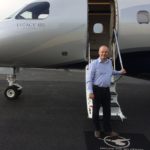A system that allows the Metropolitan Airports Commission (MAC) to generate a ‘noise picture’ for every airplane that uses Minneapolis-St. Paul International Airport (MSP) — and in turn provide a more accurate representation of aircraft sound than previously possible — has earned a US patent. Now MAC is considering how best to make the technology available to other airports.
MAC has long correlated aircraft flights with community complaints. When a complaint is filed, MAC’s various processes choose the most likely flight source. But the newly patented Airport Noise Classification Method and System delivers a much more complete noise assessment to MAC officials. Or rather, a much more complete ‘noise picture’.
Using machine learning, the system identifies sounds captured via nearly 40 sound-monitoring devices located around MSP and under common flight paths. The program classifies which sound events are aircraft, filtering out other noises common in an urban environment such as motor vehicles, lawnmowers, fireworks or weather events. Augmenting MAC’s existing methods for determining which sounds are from aircraft and which are from community sources, the program then feeds data into the commission’s sophisticated flight tracking system that helps address noise concerns, including from nearby residents.
“The technology helps solve a key question in the noise monitoring arena: ‘we have a sound, do we have an airplane?’” says MAC assistant director of terminal operations Brad Juffer, who is a co-inventor on the project. “No human or staff can efficiently decipher the thousands of inbound sound events that come through our system daily. With this classification system, we gain more reliable data to better understand overall trends impacting our airport neighbors.”
Having reliable data about aircraft noise is also important when it comes to communicating with customers, educating the pilot community and growing MSP and the area’s general aviation reliever airports, which attract traffic away from MSP to relieve congestion, Juffer tells Runway Girl Network.

Minneapolis-St Paul International Airport in Minnesota is surrounded by residential areas. Image: Metropolitan Airports Commission
The backbone of the new sound image classification system is existing technology that converts an audio file of a sound event into a picture. For instance, notes the commission, the sound image of a Boeing 737 will have a very different image compared to a neighborhood tornado siren. The system then relies on a convolutional neural network (CNN) — which is trained to conduct image recognition — to learn from an archive of known aircraft sound images and classify future data as aircraft or non-aircraft events.
“Converting the sound to an image allowed us to use image recognition capabilities. Our CNN model is trained to be considerate of pixels in relation to their neighbors. The sound events we collect from planes in motion from a stationary microphone tend to increase in amplitude over time as the plane approaches, and fade after it has passed. The sound also exists in a predictable octave band. Because of these characteristics, the pixels in certain regions of the image tend to share similarities,” Juffer explains.
MAC’s responsibility includes Minneapolis-St Paul and six general aviation reliever airports. While these reliever airports do not have permanent sound level meters positioned around them, periodic temporary sound monitoring is conducted.
“In the past three years, we’ve conducted sound monitoring at St Paul (STP), Flying Cloud (FCM), and Lake Elmo (21D). The sound image classification technology has been utilized for these temporary studies as well,” says Juffer. “And while the audio signature of a piston aircraft is different than a jet, our model has been trained on both engine types.”
Data from the seven airports is then used to create a complete operational picture from which MAC defines noise exposure areas. These are published on maps that enable local communities to proactively plan appropriate areas for development.
“We advise communities regularly regarding residential development plans near our system of airports,” says Juffer.
In addition to Juffer, the patent credits MAC’s geographic information system (GIS) solution architect Matt Baker, former MAC acoustics and data analysis coordinator Derek Anderson, and University of Minnesota doctoral student Nicholas Heller as the inventors.
“The idea was hatched after Matt Baker began to believe there was an opportunity to employ machine learning to improve a manual employee process,” notes Juffer.
Baker engaged the University of Minnesota computer science department, from where Nick Heller, a PhD student, and MAC developed the solution.
“Nick had previously done work using image recognition in the medical field and believed it could be used in this application. Derek Anderson, MAC’s acoustics and data analyst, was instrumental in working with Larson Davis, our sound level meter provider, to supply the data. As Derek and Matt’s supervisor, I provided leadership support, strategic input and ideas for the invention, and overall project management support and direction,” Juffer concludes.
The system has obvious utility in the wider industry and MAC is considering how best to make it available to other airports. “This technology has multiple other uses that are not confined to airports or transportation,” Juffer enthuses, “and the patent will help MAC offer it to others.”
Related Articles:
- Airlines oppose Schiphol flight cap aimed at cutting noise, emissions
- Optimizing transmissions to cut emissions part of ecoDemonstrator test
- The good and the not so good of LA area airport shifts
- Supersonic flight looks set to return, but at what cost?
Featured image credited to Metropolitan Airports Commission













